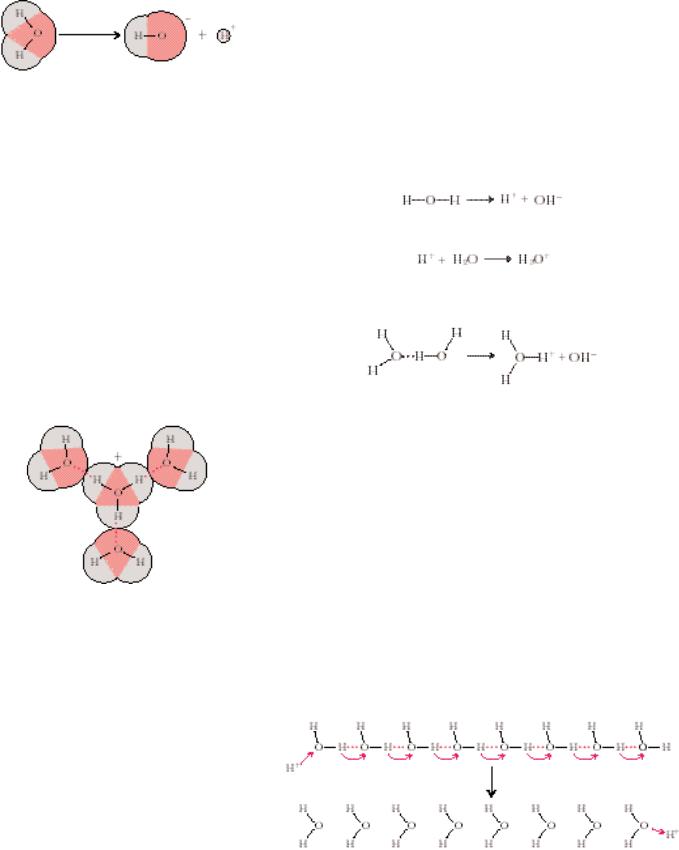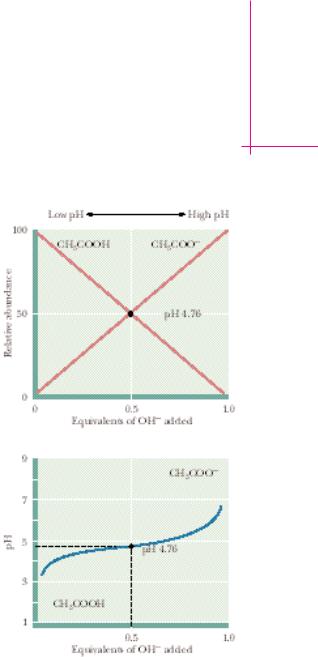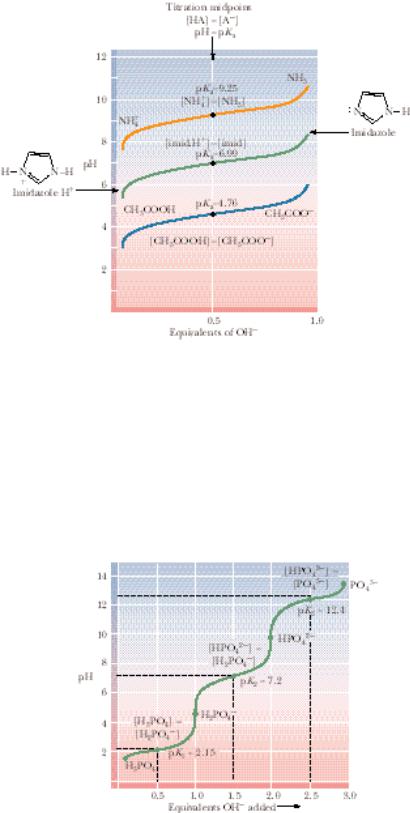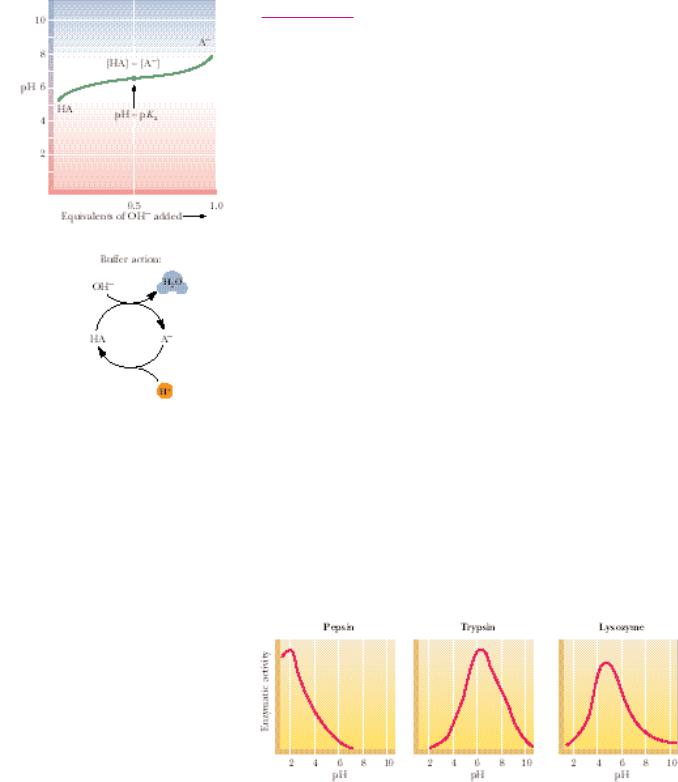
Garrett R.H., Grisham C.M. - Biochemistry (1999)(2nd ed.)(en)
.pdf
Influence of Solutes on Water Properties
The presence of dissolved substances disturbs the structure of liquid water so that its properties change. The dynamic hydrogen-bonding pattern of water must now accommodate the intruding substance. The net effect is that solutes, regardless of whether they are polar or nonpolar, fix nearby water molecules in a more ordered array. Ions, by the establishment of hydration shells through interactions with the water dipoles, create local order. Hydrophobic effects, for different reasons, make structures within water. To put it another way, by limiting the orientations that neighboring water molecules can assume, solutes give order to the solvent and diminish the dynamic interplay among H2O molecules that occurs in pure water.
Colligative Properties
This influence of the solute on water is reflected in a set of characteristic changes in behavior that are termed colligative properties, or properties related by a common principle. These alterations in solvent properties are related in that they all depend only on the number of solute particles per unit volume of solvent and not on the chemical nature of the solute. These effects include freezing point depression, boiling point elevation, vapor pressure lowering, and osmotic pressure effects. For example, 1 mol of an ideal solute dissolved in 1000 g of water (a 1 m, or molal, solution) at 1 atm pressure depresses the freezing point by 1.86°C, raises the boiling point by 0.543°C, lowers the vapor pressure in a temperature-dependent manner, and yields a solution whose osmotic pressure relative to pure water is 22.4 atm. In effect, by imposing local order on the water molecules, solutes make it more difficult for water to assume its crystalline lattice (freeze) or escape into the atmosphere (boil or vaporize). Furthermore, when a solution (such as the 1 m solution discussed here) is separated from a volume of pure water by a semipermeable membrane, the solution draws water molecules across this barrier. The water molecules are moving from a region of higher effective concentration (pure H2O) to a region of lower effective concentration (the solution). This movement of water into the solution dilutes the effects of the solute that is present. The osmotic force exerted by each mole of solute is so strong that it requires the imposition of 22.4 atm of pressure to be negated (Figure 2.8).
Osmotic pressure from high concentrations of dissolved solutes is a serious problem for cells. Bacterial and plant cells have strong, rigid cell walls to contain these pressures. In contrast, animal cells are bathed in extracellular fluids of comparable osmolarity, so no net osmotic gradient exists. Also, to minimize the osmotic pressure created by the contents of their cytosol, cells tend
2.1 ● Properties of Water |
41 |
FIGURE 2.8 ● The osmotic pressure of a 1 molal (m) solution is equal to 22.4 atmospheres of pressure. (a) If a nonpermeant solute is separated from pure water by a semipermeable membrane through which H2O passes freely,
(b) water molecules enter the solution (osmosis) and the height of the solution column in the tube rises. The pressure necessary to push water back through the membrane at a rate exactly equaled by the water influx is the osmotic pressure of the solution. (c) For a 1 m solution, this force is equal to 22.4 atm of pressure. Osmotic pressure is directly proportional to the concentration of the nonpermeant solute.

42 Chapter 2 ● Water, pH, and Ionic Equilibria
● The ionization of water.
● The hydration of H3O . Solid lines denote covalent bonds; dashed lines represent the H bonds formed between the hydronium ion and its waters of hydration.
to store substances such as amino acids and sugars in polymeric form. For example, a molecule of glycogen or starch containing 1000 glucose units exerts only 1/1000 the osmotic pressure that 1000 free glucose molecules would.
Ionization of Water
Water shows a small but finite tendency to form ions. This tendency is demonstrated by the electrical conductivity of pure water, a property that clearly establishes the presence of charged species (ions). Water ionizes because the larger, strongly electronegative oxygen atom strips the electron from one of its hydrogen atoms, leaving the proton to dissociate (Figure 2.9):
Two ions are thus formed: protons or hydrogen ions, H , and hydroxyl ions, OH . Free protons are immediately hydrated to form hydronium ions, H3O :
Indeed, because most hydrogen atoms in liquid water are hydrogen-bonded to a neighboring water molecule, this protonic hydration is an instantaneous process and the ion products of water are H3O and OH :
The amount of H3O or OH in 1 L (liter) of pure water at 25°C is 1 10 7 mol; the concentrations are equal because the dissociation is stoichiometric.
Although it is important to keep in mind that the hydronium ion, or hydrated hydrogen ion, represents the true state in solution, the convention is to speak of hydrogen ion concentrations in aqueous solution, even though “naked” protons are virtually nonexistent. Indeed, H3O itself attracts a hydration shell by H bonding to adjacent water molecules to form an H9O4 species (Figure 2.10) and even more highly hydrated forms. Similarly, the hydroxyl ion, like all other highly charged species, is also hydrated.
P roton Jumping
Because of the high degree of hydrogen bonding in water, H ions show an apparent rate of migration in an electrical field that is vastly greater than other univalent cations in aqueous solution, such as Na and K . In effect, the net transfer of a proton from molecule to molecule throughout the H-bonded network accounts for this apparent rapidity of migration (Figure 2.11).
FIGURE 2.11 ● Proton jumping via the hydrogen-bonded network of water molecules.

2.2 ● pH |
43 |
That is, the H-bonded network provides a natural route for rapid H transport. This phenomenon of proton jumping thus occurs with little actual movement of the water molecules themselves. Ice has an electrical conductivity close to that of water because such proton jumps also readily occur even when the water molecules are fixed in a crystal lattice. Such conduction of protons via H-bonded networks has been offered as an explanation for a number of rapid proton transfers of biological significance.
Kw , the Ion Product of Water
The dissociation of water into hydrogen ions and hydroxyl ions occurs to the extent that 10 7 mol of H and 10 7 mol of OH are present at equilibrium in 1 L of water at 25°C.
H2O 88n H OH
The equilibrium constant for this process is
Keq
[H ][OH ]
[H2O]
where brackets denote concentrations in moles per liter. Because the concentration of H2O in 1 L of pure water is equal to the number of grams in a liter divided by the gram molecular weight of H2O, or 1000/18, the molar concentration of H2O in pure water is 55.5 M (molar). The decrease in H2O concentration as a result of ion formation ([H ], [OH ] 10 7 M) is negligible in comparison, and thus its influence on the overall concentration of H2O can be ignored. Thus,
Keq (10 7)(10 7) 1.8 10 16 55.5
Because the concentration of H2O in pure water is essentially constant, a new constant, K w, the ion product of water, can be written as
Kw 55.5 Keq 10 14 [H ][OH ]
The equation has the virtue of revealing the reciprocal relationship between H and OH concentrations of aqueous solutions. If a solution is acidic, that is, of significant [H ], then the ion product of water dictates that the OH
concentration is correspondingly less. For example, if [H ] is 10 2 M, [OH ] must be 10 12 M (Kw 10 14 [10 2][OH ]; [OH ] 10 12 M). Similarly,
in an alkaline, or basic, solution in which [OH ] is great, [H ] is low.
2.2 ● pH
To avoid the cumbersome use of negative exponents to express concentrations that range over 14 orders of magnitude, Sørensen, a Danish biochemist, devised the pH scale by defining pH as the negative logarithm of the hydrogen ion concentration1:
pH log10 [H ]
1To be precise in physical chemical terms, the activities of the various components, not their molar concentrations, should be used in these equations. The activity (a) of a solute component is defined as the product of its molar concentration, c, and an activity coefficient, : a [c] . Most biochemical work involves dilute solutions, and the use of activities instead of molar concentrations is usually neglected. However, the concentration of certain solutes may be very high in living cells.

44 Chapter 2 ● Water, pH, and Ionic Equilibria
Table 2.2
pH Scale
The hydrogen ion and hydroxyl ion concentrations are given in moles per liter at 25°C.
pH |
|
|
[H ] |
|
|
|
|
[OH ] |
|
|
|
|
|
|
|
|
|||||
0 |
(100) |
1.0 |
|
0.00000000000001 |
(10 14) |
|||||
1 |
(10 1) |
0.1 |
|
0.0000000000001 |
(10 13) |
|||||
2 |
(10 2) |
0.01 |
|
0.000000000001 |
(10 12) |
|||||
3 |
(10 3) |
0.001 |
|
0.00000000001 |
(10 11) |
|||||
4 |
(10 4) |
0.0001 |
|
0.0000000001 |
(10 10) |
|||||
5 |
(10 5) |
0.00001 |
|
0.000000001 |
|
(10 9) |
|
|||
6 |
(10 6) |
0.000001 |
|
0.00000001 |
|
(10 8) |
|
|||
7 |
(10 7) |
0.0000001 |
|
0.0000001 |
|
(10 7) |
|
|||
8 |
(10 8) |
0.00000001 |
|
0.000001 |
|
(10 6) |
|
|||
9 |
(10 9) |
0.000000001 |
|
0.00001 |
|
(10 5) |
|
|||
10 |
(10 10) |
0.0000000001 |
|
0.0001 |
|
(10 4) |
|
|||
11 |
(10 11) |
0.00000000001 |
0.001 |
|
(10 3) |
|
||||
12 |
(10 12) |
0.000000000001 |
0.01 |
|
(10 2) |
|
||||
13 |
(10 13) |
0.0000000000001 |
0.1 |
|
(10 1) |
|
||||
14 |
(10 14) |
0.00000000000001 |
1.0 |
|
(100) |
|
||||
|
|
|
|
|
|
|
|
|
|
|
Table 2.3
The pH of Various Common Fluids
Fluid |
pH |
|
|
Household lye |
13.6 |
Bleach |
12.6 |
Household ammonia |
11.4 |
Milk of magnesia |
10.3 |
Baking soda |
8.4 |
Seawater |
8.0 |
Pancreatic fluid |
7.8–8.0 |
Blood plasma |
7.4 |
Intracellular fluids |
|
Liver |
6.9 |
Muscle |
6.1 |
Saliva |
6.6 |
Urine |
5–8 |
Boric acid |
5.0 |
Beer |
4.5 |
Orange juice |
4.3 |
Grapefruit juice |
3.2 |
Vinegar |
2.9 |
Soft drinks |
2.8 |
Lemon juice |
2.3 |
Gastric juice |
1.2–3.0 |
Battery acid |
0.35 |
|
|
Table 2.2 gives the pH scale. Note again the reciprocal relationship between [H ] and [OH ]. Also, because the pH scale is based on negative logarithms, low pH values represent the highest H concentrations (and the lowest OH concentrations, as Kw specifies). Note also that
pKw pH pOH 14
The pH scale is widely used in biological applications because hydrogen ion concentrations in biological fluids are very low, about 10 7 M or 0.0000001 M, a value more easily represented as pH 7. The pH of blood plasma, for example, is 7.4 or 0.00000004 M H . Certain disease conditions may lower the plasma pH level to 6.8 or less, a situation that may result in death. At pH 6.8, the H concentration is 0.00000016 M, four times greater than at pH 7.4.
At pH 7, [H ] [OH ]; that is, there is no excess acidity or basicity. The point of neutrality is at pH 7, and solutions having a pH of 7 are said to be at neutral pH. The pH values of various fluids of biological origin or relevance are given in Table 2.3. Because the pH scale is a logarithmic scale, two solutions whose pH values differ by one pH unit have a 10-fold difference in [H ]. For example, grapefruit juice at pH 3.2 contains more than 12 times as much H as orange juice at pH 4.3.
Dissociation of Strong Electrolytes
Substances that are almost completely dissociated to form ions in solution are called strong electrolytes. The term electrolyte describes substances capable of generating ions in solution and thereby causing an increase in the electrical conductivity of the solution. Many salts (such as NaCl and K2SO4) fit this category, as do strong acids (such as HCl) and strong bases (such as NaOH). Recall from general chemistry that acids are proton donors and bases are pro-

2.2 ● pH |
45 |
ton acceptors. In effect, the dissociation of a strong acid such as HCl in water can be treated as a proton transfer reaction between the acid HCl and the base H2O to give the conjugate acid H3O and the conjugate base Cl :
HCl H2O 88n H3O Cl
The equilibrium constant for this reaction is
K [H3O ][Cl ]
[H2O][HCl]
Customarily, because the term [H2O] is essentially constant in dilute aqueous solutions, it is incorporated into the equilibrium constant K to give a new term, Ka, the acid dissociation constant (where Ka K[H2O]). Also, the term [H3O ] is often replaced by H , such that
Ka [H ][Cl ]
[HCl]
For HCl, the value of Ka is exceedingly large because the concentration of HCl in aqueous solution is vanishingly small. Because this is so, the pH of HCl solutions is readily calculated from the amount of HCl used to make the solution:
[H ] in solution [HCl] added to solution
Thus, a 1 M solution of HCl has a pH of 0; a 1 mM HCl solution has a pH of
3. Similarly, a 0.1 M NaOH solution has a pH of 13. (Because [OH ] 0.1 M, [H ] must be 10 13 M.)
Viewing the dissociation of strong electrolytes another way, we see that the ions formed show little affinity for one another. For example, in HCl in water, Cl has very little affinity for H :
HCl 88n H Cl
and in NaOH solutions, Na has little affinity for OH . The dissociation of these substances in water is effectively complete.
Dissociation of Weak Electrolytes
Substances with only a slight tendency to dissociate to form ions in solution are called weak electrolytes. Acetic acid, CH3COOH, is a good example:
88z |
|
H3O |
|
CH3COOH H2O y88 CH3COO |
|
|
The acid dissociation constant Ka for acetic acid is 1.74 10 5:
Ka [H ][CH3COO ] 1.74 10 5 [CH3COOH]
The term Ka is also called an ionization constant because it states the extent to which a substance forms ions in water. The relatively low value of Ka for acetic acid reveals that the un-ionized form, CH3COOH, predominates over H and CH3COO in aqueous solutions of acetic acid. Viewed another way, CH3COO , the acetate ion, has a high affinity for H .
EXAMPLE
What is the pH of a 0.1 M solution of acetic acid? Or, to restate the question, what is the final pH when 0.1 mol of acetic acid (HAc) is added to water and the volume of the solution is adjusted to equal 1 L?

46 Chapter 2 ● Water, pH, and Ionic Equilibria
ANSWER
The dissociation of HAc in water can be written simply as
88z |
|
Ac |
|
HAc y88 H |
|
|
where Ac represents the acetate ion, CH3COO . In solution, some amount x of HAc dissociates, generating x amount of Ac and an equal amount x of H . Ionic equilibria characteristically are established very rapidly. At equilibrium, the concentration of HAc Ac must equal 0.1 M. So, [HAc] can be represented as (0.1 x) M, and [Ac ] and [H ] then both equal x molar. From 1.74 10 5 ([H ][Ac ])/[HAc], we get 1.74 10 5 x2/[0.1 x]. The solution to quadratic equations of this form (ax2 bx c 0) is x ( bb2 4ac) 2a. However, the calculation of x can be simplified by noting that, because Ka is quite small, x 0.1 M. Therefore, Ka is essentially equal to x2/0.1. This simplification yields x2 1.74 10 6, or x 1.32 10 3 M and pH 2.88.
Henderson–Hasselbalch Equation
Consider the ionization of some weak acid, HA, occurring with an acid dissociation constant, Ka. Then,
88z |
|
A |
|
HA y88 H |
|
|
and
Ka [H ][A ] [HA]
Rearranging this expression in terms of the parameter of interest, [H ], we have
[H ] |
Ka[HA] |
|
|
|
|
[A ] |
|
|
|
||
|
|
|
|
||
Taking the logarithm of both sides gives |
|
|
|
||
log [H ] log Ka log10 |
[HA] |
||||
[A |
|
] |
|||
|
|
|
|
||
If we change the signs and define pKa log Ka, we have
[HA] pH pKa log10 [A ]
or
[A ] pH pK a log10 [HA]
This relationship is known as the Henderson–Hasselbalch equation. Thus, the pH of a solution can be calculated, provided Ka and the concentrations of the weak acid HA and its conjugate base A are known. Note particularly that when [HA] [A ], pH pKa. For example, if equal volumes of 0.1 M HAc and 0.1 M sodium acetate are mixed, then
pH pKa 4.76
pKa log Ka log10 (1.74 10 5) 4.76
(Sodium acetate, the sodium salt of acetic acid, is a strong electrolyte and dissociates completely in water to yield Na and Ac .)

2.2 ● pH |
47 |
Table 2.4
Acid Dissociation Constants and pKa Values for Some Weak Electrolytes (at 25°C)
Acid |
Ka (M) |
pKa |
|
HCOOH (formic acid) |
1.78 |
10 4 |
3.75 |
CH3COOH (acetic acid) |
1.74 |
10 5 |
4.76 |
CH3CH2COOH (propionic acid) |
1.35 |
10 5 |
4.87 |
CH3CHOHCOOH (lactic acid) |
1.38 |
10 4 |
3.86 |
HOOCCH2CH2COOH (succinic acid) pK1* |
6.16 |
10 5 |
4.21 |
HOOCCH2CH2COO (succinic acid) pK2 |
2.34 |
10 6 |
5.63 |
H3PO4 (phosphoric acid) pK1 |
7.08 |
10 3 |
2.15 |
H2PO4 (phosphoric acid) pK2 |
6.31 |
10 8 |
7.20 |
HPO42 (phosphoric acid) pK3 |
3.98 |
10 13 |
12.40 |
C3N2H5 (imidazole) |
1.02 |
10 7 |
6.99 |
C6O2N3H11 (histidine–imidazole group) pKR† |
9.12 |
10 7 |
6.04 |
H2CO3 (carbonic acid) pK1 |
1.70 |
10 4 |
3.77 |
HCO3 (bicarbonate) pK2 |
5.75 |
10 11 |
10.24 |
(HOCH2)3CNH3 (tris-hydroxymethyl aminomethane) |
8.32 |
10 9 |
8.07 |
NH4 (ammonium) |
5.62 |
10 10 |
9.25 |
CH3NH3 (methylammonium) |
2.46 |
10 11 |
10.62 |
*These pK values listed as pK1, pK2, or pK3 are in actuality pKa values for the respective dissociations. This simplification in notation is used throughout this book.
†pKR refers to the imidazole ionization of histidine.
Data from CRC Handbook of Biochemistry, The Chemical Rubber Co., 1968.
The Henderson–Hasselbalch equation provides a general solution to the quantitative treatment of acid–base equilibria in biological systems. Table 2.4 gives the acid dissociation constants and pKa values for some weak electrolytes of biochemical interest.
EXAMPLE
What is the pH when 100 mL of 0.1 N NaOH is added to 150 mL of 0.2 M
HAc if pKa for acetic acid 4.76?
ANSWER
100 mL 0.1 N NaOH 0.01 mol OH , which neutralizes 0.01 mol of HAc, giving an equivalent amount of Ac :
OH HAc 88n Ac H2O
0.02 mol of the original 0.03 mol of HAc remains essentially undissociated. The final volume is 250 mL.
pH pKa log10 [Ac ] 4.76 log (0.01 mol)/(0.02 mol) [HAc]
pH 4.76 log10 2 4.46
If 150 mL of 0.2 M HAc had merely been diluted with 100 mL of water, this would leave 250 mL of a 0.12 M HAc solution. The pH would be given by:

48 Chapter 2 ● Water, pH, and Ionic Equilibria
Ka |
[H ][Ac ] |
|
x2 |
1.74 10 5 |
|
[HAc] |
0.12 M |
||||
|
|
|
|||
x |
1.44 10 3 [H ] |
|
|||
pH 2.84
Clearly, the presence of sodium hydroxide has mostly neutralized the acidity of the acetic acid through formation of acetate ion.
● The titration curve for acetic acid. Note that the titration curve is relatively flat at pH values near the pKa; in other words, the pH changes relatively little as OH is added in this region of the titration curve.
Titration Curves
Titration is the analytical method used to determine the amount of acid in a solution. A measured volume of the acid solution is titrated by slowly adding a solution of base, typically NaOH, of known concentration. As incremental amounts of NaOH are added, the pH of the solution is determined and a plot of the pH of the solution versus the amount of OH added yields a titration curve. The titration curve for acetic acid is shown in Figure 2.12. In considering the progress of this titration, keep in mind two important equilibria:
1. |
88z |
|
Ac |
|
5 |
||
HAc y88 H |
|
|
Ka 1.74 10 |
||||
2. |
H OH 88n H2O |
K |
[H2O] |
5.55 1015 |
|||
|
|||||||
|
|
|
|
|
|
K w |
|
As the titration begins, mostly HAc is present, plus some H and Ac in amounts that can be calculated (see the Example on page 45). Addition of a solution of NaOH allows hydroxide ions to neutralize any H present. Note that reaction (2) as written is strongly favored; its apparent equilibrium constant is greater than 1015! As H is neutralized, more HAc dissociates to H and Ac . As further NaOH is added, the pH gradually increases as Ac accumulates at the expense of diminishing HAc and the neutralization of H . At the point where half of the HAc has been neutralized, that is, where 0.5 equivalent of OH has been added, the concentrations of HAc and Ac are equal and pH pKa for HAc. Thus, we have an experimental method for determining the pKa values of weak electrolytes. These pKa values lie at the midpoint of their respective titration curves. After all of the acid has been neutralized (that is, when one equivalent of base has been added), the pH rises exponentially.
The shapes of the titration curves of weak electrolytes are identical, as Figure 2.13 reveals. Note, however, that the midpoints of the different curves vary in a way that characterizes the particular electrolytes. The pKa for acetic acid is 4.76, the pKa for imidazole is 6.99, and that for ammonium is 9.25. These pKa values are directly related to the dissociation constants of these substances, or, viewed the other way, to the relative affinities of the conjugate bases for protons. NH3 has a high affinity for protons compared to Ac ; NH4 is a poor acid compared to HAc.
Phosphoric Acid Has Three Dissociable H
Figure 2.14 shows the titration curve for phosphoric acid, H3PO4. This substance is a polyprotic acid, meaning it has more than one dissociable proton. Indeed, it has three, and thus three equivalents of OH are required to neutralize it, as Figure 2.14 shows. Note that the three dissociable H are lost in discrete steps, each dissociation showing a characteristic pKa. Note that pK1 occurs at pH 2.15, and the concentrations of the acid H3PO4 and the conjugate base H2PO4 are equal. As the next dissociation is approached, H2PO4

2.2 ● pH |
49 |
FIGURE 2.13 ● The titration curves of several weak electrolytes: acetic acid, imidazole, and ammonium. Note that the shape of these different curves is identical. Only their position along the pH scale is displaced, in accordance with their respective affinities for H ions, as reflected in their differing pKa values.
is treated as the acid and HPO42 is its conjugate base. Their concentrations are equal at pH 7.20, so pK2 7.20. (Note that at this point, 1.5 equivalents of OH have been added.) As more OH is added, the last dissociable hydrogen is titrated, and pK3 occurs at pH 12.4, where [HPO42 ] [PO43 ].
A biologically important point is revealed by the basic shape of the titration curves of weak electrolytes: in the region of the pKa, pH remains relatively unaffected as increments of OH (or H ) are added. The weak acid and its conjugate base are acting as a buffer.
FIGURE 2.14 ● The titration curve for phosphoric acid. The chemical formulas show the prevailing ionic species present at various pH values. Phosphoric acid (H3PO4) has three titratable hydrogens and therefore three midpoints are seen: at pH 2.15 (pK1), pH 7.20 (pK2), and pH 12.4 (pK3).

50 Chapter 2 ● Water, pH, and Ionic Equilibria
2.3 ● Buffers
● A buffer system consists of a weak acid, HA, and its conjugate base, A . The pH varies only slightly in the region of the titration curve where [HA] [A ]. The unshaded box denotes this area of greatest buffering capacity. Buffer action: when HA and A are both available in sufficient concentration,
the solution can absorb input of either H or OH , and pH is maintained essentially constant.
Buffers are solutions that tend to resist changes in their pH as acid or base is added. Typically, a buffer system is composed of a weak acid and its conjugate base. A solution of a weak acid that has a pH nearly equal to its pKa by definition contains an amount of the conjugate base nearly equivalent to the weak acid. Note that in this region, the titration curve is relatively flat (Figure 2.15). Addition of H then has little effect because it is absorbed by the following reaction:
H A 88n HA
Similarly, added OH is consumed by the process
OH HA 88n A H2O
The pH then remains relatively constant. The components of a buffer system are chosen such that the pKa of the weak acid is close to the pH of interest. It is at the pKa that the buffer system shows its greatest buffering capacity. At pH values more than one pH unit from the pKa, buffer systems become ineffective because the concentration of one of the components is too low to absorb the influx of H or OH . The molarity of a buffer is defined as the sum of the concentrations of the acid and conjugate base forms.
Maintenance of pH is vital to all cells. Cellular processes such as metabolism are dependent on the activities of enzymes, and in turn, enzyme activity is markedly influenced by pH, as the graphs in Figure 2.16 show. Consequently, changes in pH would be very disruptive to metabolism for reasons that become apparent in later chapters. Organisms have a variety of mechanisms to keep the pH of their intraand extracellular fluids essentially constant, but the primary protection against harmful pH changes is provided by buffer systems. The buffer systems selected reflect both the need for a pKa value near pH 7 and the compatibility of the buffer components with the metabolic machinery of cells. Two buffer systems act to maintain intracellular pH essentially con- stant—the phosphate (HPO42 /H2PO4 ) system and the histidine system. The pH of the extracellular fluid that bathes the cells and tissues of animals is maintained by the bicarbonate/carbonic acid (HCO3 /H2CO3) system.
FIGURE 2.16 ● pH versus enzymatic activity. The activity of enzymes is very sensitive to pH. The pH optimum of an enzyme is one of its most important characteristics. Pepsin is a protein-digesting enzyme active in the gastric fluid. Trypsin is also a proteolytic enzyme, but it acts in the more alkaline milieu of the small intestine. Lysozyme digests the cell walls of bacteria; it is found in tears.
